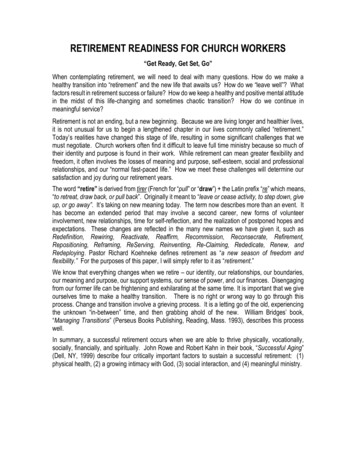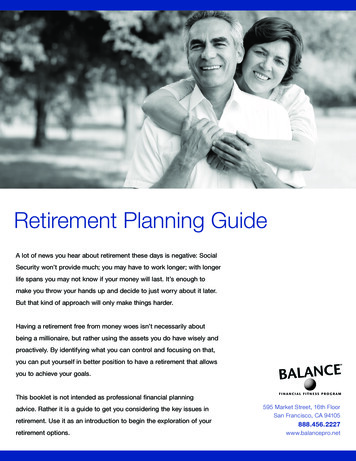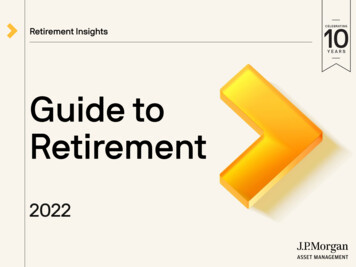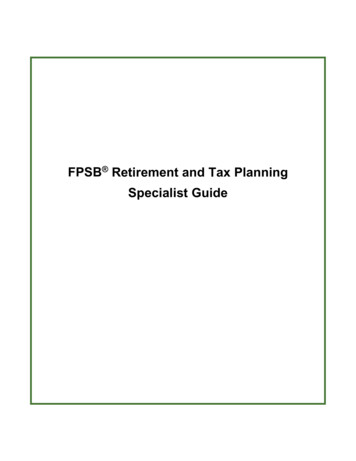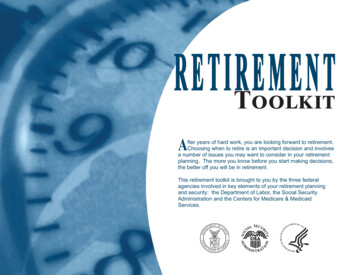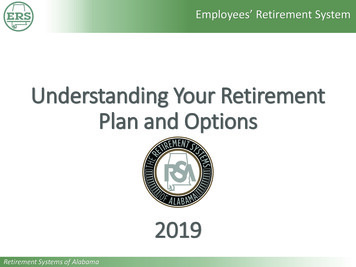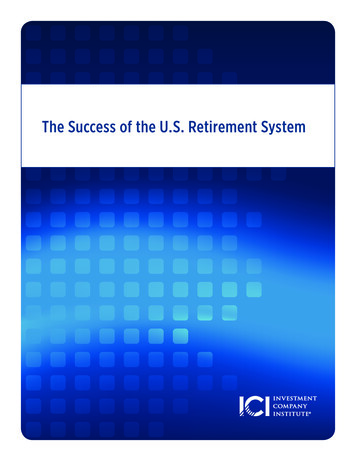
Transcription
KPERS 1KPERS 2Getting Ready toRetireKPERS Pre-Retirement Planning Guide KPERS
Contacting UsWe’re here to answer your questions and help in any way we can. Our offices are open Mondaythrough Friday from 8 a.m. to 5 p.m. The InfoLine is open from 8 a.m. to 4 p.m. Your questions,comments and suggestions are always welcome.Web Site:Toll Free:In 166kpers@kpers.org611 S. Kansas Ave., Suite 100,Topeka, KS 66603-3869
Table of ContentsCountdown to Retirement ChecklistYour Benefits Will Be There4 5 Plan Your RetirementYou’ll Need More Than Just Your PensionKPERS 1 – When Can You Retire? 6KPERS 2 – When Can You Retire? 7Disability vs. Retirement7 Calculating Your Retirement BenefitYour Final Average Salary6 8 8 Increasing Your Benefit (Purchasing Service Credit)Choosing Your Retirement Date10 Estimating Your Monthly Retirement BenefitRetirement Benefit Payment Options Steps in the Retirement Process16Life Insurance9 11 1317 Health Insurance 17Divorce and Your KPERS Benefits17 After RetirementReceiving Your Monthly Retirement Benefit PaymentsState and Federal Income Taxes Cost-of-Living Adjustments (COLAs)Retiree Death Benefit 1818 2020 Keeping Your Personal Information Up-to-DateYour Beneficiary 2020Working After You Retire 227/20
Countdown to Retirement Checklist4 Learn about the steps to retirement. KPERS hosts in-person seminars and online webinarsdesigned to help you navigate the last steps to retirement. Each free session covers a variety oftopics directly related to your KPERS retirement. Find out when you are eligible to retire. Knowing when you’ll meet the age and servicerequirements to retire can help you decide on the best retirement date. Calculate a retirement benefit estimate. You can calculate your own estimate online by loggingin to your personal account at kpers.org. You can also complete a Benefit Estimate Request form(KPERS-15E) and we can calculate an estimate for you. Your employer can help you complete theform with the most accurate pay information. Please allow 4 weeks to process. Review the KPERS Retirement Options publication to understand your benefit payment options.You can use the benefit calculator at kpers.org to see how taking a partial lump-sum option orproviding a benefit for someone after your death affect your benefit amount. Complete an Application for Retirement Benefits form (KPERS-15). Submit your application atleast 30 days before your retirement date. You need to apply to receive your benefits. They do notbegin automatically. You will need to provide birth and name change documents. Review your life insurance. If you would like to continue your basic and optional group lifeinsurance in retirement, you have two options: keep your group coverage and pay an increasedpremium or convert your coverage to an individual policy. See your employer or our web site formore information on your choices. Determine your tax/withholding requirements. In general, your benefits will be subject to federalincome taxes, but not Kansas state income taxes. If you are going to live in another state, check ifyour retirement benefit is taxable in that state. Confirm your Social Security benefits. Get accurate information about Social Security applicationsand benefits by calling the Social Security Administration’s toll-free number, 1-800-772-1213 orcontacting your local SSA office. Determine your health insurance needs. If you have been with your current employer for tenyears or more, Kansas law allows you to remain in your current health plan by paying the entirepremium. Contact your employer’s personnel office for more information. If you’re close to age65, check into your Medicare options at your local Social Security office. Review your other retirement income sources. You’ll need a method for turning your retirementsavings and investments into income. Different plans have different payout options andrequirements. To figure out the best way to supplement your KPERS benefits, you’ll need toconsider all your options. To learn more, contact your plan administrator. Pre-Retirement Planning Guide
From the Executive DirectorYour Benefits Will Be ThereMembers sometimes express concern over whether their KPERS benefits will be therewhen they retire.When they call in, or ask questions during a KPERS presentation, here is what wetell them: “Please don’t worry. There is certainly reason for all of us to increase ourattention on KPERS’ funding, but not enough to make you doubt if your benefits will bethere for you when it’s time.”KPERS is a prefunded system. That means contributions and investment returnscome in during your career to pay for your benefits when you retire. Right nowmore than 1 billion in contributions come in each year. This alone would almost cover the cost of currentannual benefits. And then there is investment income. Over time, investments account for more than half ofannual income to the Trust Fund.KPERS manages more than 20 billion inassets. Your assets. Over time, the Systemhas continued to earn an annual investment average of over 8%, a bit morethan our 7.75% target. The Trust Fund isyour money. And no one can take it outexcept to pay your benefits. Not even theLegislature or Governor.The Trust Fund has more than tripledover the last 25 years. However, KPERSdoes have a long-term funding shortfall.And it’s been more than two decades in25KPERS Trust Fund Growth Over Time 20.8B20 16.9B15 11.9B 9.9B1050 12.9B 5.8B199520002005201020152019the making. We cannot invest our wayout. It will take both time and the rightlevel of employer contributions to fix it.You are likely to continue to hear about KPERS in the media in the months and years to come. But we areyour fiduciary. We are here to watch out for your best financial interest and keep funding needs in front of theLegislature. Rest assured, your benefit will be there.kpers.org 5
You’ll Need More Than Just Your PensionMost financial experts suggest replacing at least 80% of your income for retirement. Increasing healthcare costs and living longer may mean you need to have even more.Plan Your RetirementKPERS and Social Security won’t be enough for a sound retirement. You need to save on your own, too. The easiest way to saveis through an eligible employer plan like a 457(b) deferred compensation or a 403(b) annuity plan. Check with your employer aboutoptions where you work.PersonalSavingsThe State of Kansas and many local public employers offer KPERS457, a deferred compensation savings plan. Contributions are automatically deducted from your pay, and you can get started with aslittle as 12 per pay period. Visit kpers457.org for more info.yourretirementincomeHowever you choose to save, the important thing is to start. The sooneryou begin, the more time your money has to grow. Socking away evena sliver of your salary could have a big impact on your retirement.KPERS 1 – When Can You Retire? Age 65 with at least one year of service credit Age 62 with at least ten years of service credit Any age when your age and years of service credit addedtogether equal 85 (see “How to Calculate Your 85 Points”)SocialSecurityKPERSAre You a KPERS 1 Member? Hired before July 1, 2009 Active member on July 1, 2009Please note: Two service quarters round to one year. Your age is determined by your last birthday andis not rounded up.How to Calculate Your “85 Points”KPERS 1 members can retire anytime with “85 points.” The 85 point rule is when your age and years ofservice added together equal 85. Every year you work, you gain two points – one for each birthday andone for the year of service. The 85 point rule is only one of the three ways you can qualify for retirement.Find out when you’ll have 85 pointsExample61. Your current age: John is 50 years old.2. Your current years of service: He has 25 years of service.3. *Your current point total (Line 1 Line 2): 50 25 75 points now4. Number of points needed (85–Line 3): 85–75 10 points needed5. Number of years to reach 85 points (Line 4 2): 10 2 5 years to go6. Your current age (same as Line 1): 50 years old7. You will have 85 points at age (Line 5 Line 6): 50 5 55 years old* If line 3 equals 85 or greater, you can retire now with full benefits.John can retire at age 55 with 30 years of service. Pre-Retirement Planning Guide
Retiring EarlyYou can receive reduced benefits at age 55with at least ten years of service, even without the 85 points. Keep in mind your benefitswill be permanently reduced.If You Retire Early . KPERS 1ExampleReduction62Full benefit 1,500/month0%60Reduced benefit 1,425/month5%55Reduced benefit 885/month41%KPERS 2 – When Can You Retire?Plan Your Retirement Benefits are reduced by 0.6% for eachmonth you are between age 55 and 60. Benefits are reduced by 0.2% for eachmonth you are between age 60 and 62.AgeAre You a KPERS 2 Member? Age 65 with five years of service credit Age 60 with 30 years of service credit Hired on or after July 1, 2009Please note: Two service quarters round to one year. Your age isdetermined by your last birthday and is not rounded up. Active member on July 1, 2009and before January 1, 2015Retiring EarlyYou can receive reduced benefits beginning at age 55 with ten years of service. The earlier you retire,the more your benefit is reduced. If you retire before age 60 with at least 30 years of service, there isless of a reduction to your benefit.If You Retire Early . KPERS 2AgeExample–less than 30 years of serviceReductionExample–at least 30 years of serviceReduction65Full benefit 1,500/month0%Full benefit 1,500/month0%60Reduced benefit 930/month38%Full benefit 1,500/month0%55Reduced benefit 600/month60%Reduced benefit 1,050/month30%Disability vs. RetirementLong-term disability coverage through KPERS is one of your valuable employee benefits. If you areretiring because of health reasons, talk with your employer or a KPERS representative about youroptions. To qualify for disability benefits for the first 24 months, you must be disabled from performingthe duties of your current job. After 24 months, you must be disabled from performing the duties of anyjob to continue receiving benefits.kpers.org 7
Calculating Your Retirement BenefitKPERS retirement benefits are calculated using the following formula:Final average salary x statutory multiplier x years of service annual benefitPlan Your RetirementIf you are a KPERS 1 member: Service before January 1, 2014, has a statutory multiplier of 1.75%. Service after January 1, 2014, has a statutory multiplier of 1.85%.KPERS 1 ExampleFinal average salary x statutory multiplier x years of servicexx1.75%20 40,000xx1.85%10 40,000total annual benefit annual benefit 14,000 7,400 21,400If you are a KPERS 2 member: All service has a statutory multiplier of 1.85%.KPERS 2 ExampleFinal average salary x statutory multiplier x years of service annual benefitxx 1.85%30 22,200 40,000You can calculate a benefit estimate by logging in to your personal account at kpers.org.The benefit calculator uses your personal data to create quick, accurate estimates.Your Final Average SalaryIn addition to your years of service and your statutory multiplier, your final average salary is one of thefactors used when calculating retirement benefits.KPERS 1If your membership date is on or after July 1, 1993, your final average salary is: A three-year salary average excluding additional compensation.* This three-year average is based onyour three highest years of pay during your career. They do not have to be continuous years.If your membership date is before July 1, 1993, or you were in your “year of service” waiting for membership onJuly 1, 1993, your final average salary is the higher of: A three-year salary average excluding additional compensation.* This three-year average is basedon your three highest years of pay during your career. They do not have to be continuous years. A four-year salary average including additional compensation.* This four-year average is basedon your four highest years of pay during your career. They do not have to be continuous years.KPERS will calculate both options and use whichever is higher to calculate your retirement benefit. Ifadd-on pay is included in your final average salary, it is spread over all the days that you worked in thecalendar year you retired. It is not credited only to the quarter in which you were paid for it.*Additional Compensation or “add-on pay” is compensation from your employer for unused sickleave, annual leave, etc. KPERS cannot use an early retirement incentive or severance pay as part ofadd-on pay when calculating your final average salary.8 Pre-Retirement Planning Guide
School Employees: School employees under a contract have special guidelines. This includes faculty,principals and superintendents. If your position requires a teaching certificate, then you are includedin this group.Plan Your RetirementGenerally, school employees (with a membership date before July 1, 1993) who remain on the payrollthrough the end of their contract can include “add-on pay” in their final average salary. Employeeswho retire before completing their contract cannot use “add-on pay” in their final average salary. Theend of the contract may or may not coincide with the end of the school year.KPERS 2Your final average salary is an average of your five highest years of salary, excluding additional compensation, such as payments for unused sick and annual leave.Final Average Salary CapIf your salary increases substantially from year to year, a cap on compensation may be used to calculateyour final average salary. Generally, the cap applies when your salary changes and your position doesnot. For KPERS 1, the cap is 15%. For KPERS 2, the cap is 7.5%.Increasing Your Benefit (Purchasing Service Credit)You may be able to increase your retirement benefit and possibly retire earlier by purchasing servicecredit for your past public service. If your service is eligible, you can purchase service credit with alump-sum payment or by making additional contributions to the Retirement System through payrolldeduction. The cost is based on actuarial factors and tables. Only active, contributing members maypurchase service credit, and all payments must be received on or before your last day on your employer’s payroll.Benefit of Purchasing Service CreditKPERS 1 (1.75% multiplier)KPERS 2 (1.85% multiplier)Your final average salaryFor each additional year of service, your benefit increases by . 30,000 43.75 per month 525 per year 46.75 per month 555 per year 50,000 73 per month 875 per year 77 per month 925 per year 70,000 102 per month 1,225 per year 108 per month 1,295 per yearTypes of Service Credit You Can Purchase “Year of Service” (First year worked to become eligible for membership. Only for non-schoolmembers who worked in a benefits-eligible position before July 1, 2009.) Forfeited KPERS service (years you “withdrew” from KPERS if you left the System for a while) Military service Elected official service Out-of-state teaching In-state or out-of-state non-federal public service Forfeited TIAA-CREF (Board of Regents) service VISTA and Peace Corps Waiting period for Regents plan eligibilitykpers.org 9
Military ServicePlan Your RetirementMembers can purchase year for year of active military service and one quarter of service credit for eachyear of military reserve service. In certain circumstances, Kansas law allows the Retirement System togrant active military service at no cost to you if the military service interrupts your public service. Youmust be employed in a benefits-eligible position immediately before and immediately after the activemilitary service. You must be off your employer’s payroll during this military service to have servicecredit granted. Granted service is limited to five years. You can purchase up to six years of militaryservice regardless of how many years are granted.Payment Options Payroll deduction over a period of time, pre-tax Rollover or trustee-to-trustee transfer from another retirement plan. Eligible plans include agovernmental 457(b) plan such as KPERS 457, the State’s deferred compensation plan,a 403(b) annuity or an individual retirement account (IRA), pre-tax Lump sum (personal check, money order or Discover Card) after taxesFederal Tax Requirements on Service PurchasesKPERS is a “qualified plan” under federal tax provisions. Under a qualified plan, members makecontributions on a pre-tax basis and interest grows tax-deferred. Federal law may limit your lump-sumpayment if you are purchasing service with after-tax money.The Purchase Process1.2.3.4.5.6.7.Contact the Retirement System to see if your past service is eligible.If your service is eligible, complete an Application to Purchase Service Credit (KPERS-67) form.Your employer completes the employer part of the form and sends it to the Retirement System.The Retirement System calculates your purchase cost and sends a letter to you through youremployer. Be sure to weigh the cost and benefit before continuing with the purchase.To complete the purchase, you sign the necessary paperwork, arrange for payment and returnboth to the Retirement System.The Retirement System receives your payment or payroll deduction commitment.The Retirement System adds service to your record after the purchase is completed.Choosing Your Retirement DateYour retirement date can be the first day of any month, as long as you are off your employer’s payroll.School members under the continuing contract law must wait until June 1 or after. When choosing yourretirement date, keep in mind that any remainder after your quarters of service are converted to yearsof service is rounded up or down. Your rounding quarter is the point where your service rounds upto the next year. Sometimes working even a few more days can make a difference and could mean anextra year of service used for calculating your retirement benefit.Rounding Quarters You only need to work one day in a quarter to earn credit for the entire quarter. Rounding quarters are not the same for everybody. They are based on hire date and how youremployer tracks financial quarters. Contact KPERS to find out your exact rounding quarter. This can help you decide on your bestretirement date.10 Pre-Retirement Planning Guide
Estimating Your Monthly Retirement BenefitYou can calculate an estimate through your online account or with the generic benefit calculator atkpers.org. You can also submit a Benefit Estimate Request form (KPERS-15E), and we can calculatean estimate for you. Estimates are a wise step when considering your options.Keep in mind that estimates are just estimates. They can vary from your actual benefit amount becauseof the accuracy of information. Your actual benefit is calculated when you apply for retirement.Plan Your RetirementAccount Access CalculatorLogin to your online KPERS account through kpers.org. When you start a new estimate, the systemwill automatically add your membership information, including the earliest date you are eligible forfull retirement. You can use this pre-populated information or add your own. You can name and saveestimates with different scenarios for future reference.Login or createa new accounthere.After You Login to Your AccountFrom Your Homepage, select your account. You'll then see your Account Summary. To start a benefitestimate, click “Benefit Calculator” on the sidebar.kpers.org 11
Enter Your Personal InformationPlan Your RetirementName your estimate in Step 1 if you wish to save it. You can use the pre-populated informationor add your own.Note: Example is a KPERS 1 member. Statutory multiplier is 1.85% for KPERS 1 service earned after January 1, 2014.View Your Monthly and Lump-Sum OptionsThe higher your lump sum at retirement, the lower your monthly benefits will be.Monthly benefits are also reduced to provide on-going survivor benefits after your death.12 Pre-Retirement Planning Guide
Generic KPERS 1 Calculator at kpers.orgAccess the generic calculator on kpers.org. Links are below the Member Account login. With thiscalculator, you add your own information. Your last annual statement will be helpful.Plan Your RetirementRetirement Benefit Payment OptionsAs a retired KPERS member, you will receive a monthly retirement benefit for the rest of your life. Inaddition, KPERS has retirement payment options that add financial flexibility and allow you to providefor loved ones after your death. The decision about which option to take is crucial, because once youmake a choice, you cannot change it.Scenario for All of Our ExamplesHere is the scenario we’ll use for all of our payment option examples:Dan is a KPERS 1 member retiring at age 65. His wife, Sue, is age 62. Dan’s final average salary is 39,216, and he has 26 years of service. His retirement benefit is calculated using the following formula:Final average salary x statutory multiplier x years of servicexx1.75%22 39,216xx1.85%4 39,216total annual benefit annual benefit 15,098 2,902 18,000If Dan were a KPERS 2 member, his benefit is calculated with all service at the 1.85% statutory multiplier.Maximum Monthly Benefit OptionKPERS will first establish your maximum monthly benefit amount. This amount will provide thebasis for the rest of your options. You can choose to stay with this maximum monthly benefit amountwithout any survivor options. You will then receive a payment each month for this same amount forthe rest of your life. After your death, your beneficiary will receive the balance of any remaining moneythat you contributed to KPERS. There is no continued benefit after your death.ExampleDan’s annual benefit is 18,000. 18,000 12 1,500 per monthkpers.org 13
Joint-Survivor OptionsYou may want to provide a continuing monthly benefit for someone after your death. You can do thisby choosing a joint-survivor option. Your survivor, also called a joint annuitant, cannot be changed onceyou retire. After your death, your survivor will receive a monthly benefit for the rest of his or her life.Plan Your RetirementThe three joint-survivor options: 50% 75% 100%The percentages show your survivor’s benefit amount compared to your benefit amount. Your survivorcan receive 50% of your benefit amount or 75%. You can also choose the 100% option, and he or shewill receive the same benefit amount that you received before your death.In order to provide the continuing benefit, your regular monthly benefits will be reduced. The higheryour survivor’s benefit, the lower yours will be during retirement.If your named survivor dies firstIf your named survivor dies before you, your survivor option is canceled and your benefit increasesto your original maximum monthly benefit amount. You cannot name another person to receive asurvivor benefit.Adjusting for age differenceThe difference between your ages also affects your benefit amount. If your survivor is younger than you,your benefit will be decreased more than if your survivor is older. Actuarial tables and factors are used tocalculate these adjustments.Example–KPERS 1Dan’s maximum monthly benefit is 1,500. Hechooses the 50% joint-survivor option for hiswife, Sue. Dan’s benefit is reduced by a factorfrom an actuarial table to provide the survivorbenefit and to adjust for the 3-year age difference.Example–KPERS 2Dan’s maximum monthly benefit is 1,500. Hechooses the 50% joint-survivor option for hiswife, Sue. Dan’s benefit is reduced by a factorfrom an actuarial table to provide the survivorbenefit and to adjust for the 3-year age difference.Life-Certain OptionsDan’s monthly maximum 1,500Reduced for survivor benefit and age differencex .898Dan’s adjusted monthly benefit 1,347Sue’s monthly survivor benefit (50% of Dan’s) 673.50Dan’s monthly maximum 1,500Reduced for survivor benefit and age differencex .931764Dan’s adjusted monthly benefit 1398Sue’s monthly survivor benefit (50% of Dan’s) 699With a life-certain option, you’ll receive a monthly benefit for the rest of your life. But, if you die withinthe chosen period of time from your retirement date, your beneficiary will receive the same monthly benefit you have been receiving for the rest of the guaranteed payment period. You can change beneficiariesat any time, and you can have any number of beneficiaries at once. They will share the benefit equally.The three life-certain options: 5-year guaranteed payment period 10-year guaranteed payment period 15-year guaranteed payment period14 Pre-Retirement Planning Guide
In order to provide the continuing benefit, your regular monthly benefits will be reduced. The longerthe guaranteed period, the more your benefit is reduced. The KPERS 2 benefit option is also affected byyour age at retirement. The older you are, the more your benefit is reduced. The KPERS 1 option usesfixed percentages to calculate adjustments. KPERS 2 uses actuarial tables and factors.KPERS 1 Life Certain OptionsKPERS 2 Life Certain OptionsReduced Benefit Amount9610098%95%928888%84805 yr10 yr15 yrguaranteed period, any age% of max benefit% of max benefit1009699.8% 99.5%98.6%97.4%9296.9%Plan Your RetirementReduced Benefit Amount94.5%888480 age 605 yr age 6510 yr15 yrguaranteed period, sample by ageExampleDan’s maximum monthly benefit is 1,500. He chooses the ten-year life certain option for his wife, Sue.Dan’s benefit is reduced to 95% to provide the survivor benefit. He receives 1,425 a month for the restof his life, no matter how long he lives.Dan dies seven years after he retires. As his chosen beneficiary, Sue will receive 1,425 a month forthree more years. Dan’s seven years plus Sue’s three total the ten years Dan was guaranteed. If Dan hadnamed his two daughters as beneficiaries instead of Sue, the daughters would share the 1,425 monthlybenefit and each would receive 712.50 a month for three years.If Dan were a KPERS 2 member, his benefit would be reduced by the reduction factor for age 65 froman actuarial table (0.97398 or about 97.4%) for a monthly benefit of 1,460.97.Partial Lump-Sum Option (PLSO)You can take part of your retirement benefit in an up-front lump sum at retirement. This lump sum isthen combined with one of the other retirement options to provide reduced, regular monthly paymentsfor the rest of your life. Choosing the PLSO will reduce your monthly benefits, no matter which other option youchoose. A PLSO payment is taxable income unless directly rolled over into an eligible retirement account.KPERS 1 members have the PLSO available in 10, 20, 30, 40 or 50% amounts. KPERS 2 members canchoose a 10, 20 or 30% option. The percentage you select determines the size of the lump sum andthe decrease in your monthly benefit.ExampleA 30% PLSO payment would result in a single lump-sum payment equal to 30% of the actuarial presentvalue of your lifetime benefit, along with a permanent 30% reduction in your monthly benefit.Dan’s maximum monthly benefit is 1,500. He chooses a 30% lump sum with the maximum monthlybenefit. Dan receives a lump sum of 49,659 at retirement, and his monthly benefit is reduced by 30%to 1,050.Note: If you select a partial lump-sum option or a payment option where your spouse would receive lessthan one-half of your monthly retirement benefit when you die, your spouse’s notarized signature must beon your retirement application, signifying he or she knows the retirement benefit option you chose.kpers.org 15
Things to Consider Before Taking a PLSO Choosing a PLSO creates a lifetime reduction in your benefit. Can you make up the reduction inmonthly benefits with potential gains with investments? A PLSO payment is eligible for rollover into a qualified retirement account. KPERS is required towithhold 20% federal withholding if a payment is made directly to you. You may be subject to a 10%IRS penalty if you are under age 59 ½.Plan Your RetirementSteps in the Retirement Process1.Calculate a benefit estimate by logging in to your personal account through kpers.org. Or use thegeneric calculators on our website.2.Review the KPERS Retirement Options publication to consider your payment options.3.Submit your Application for Retirement form (KPERS-15) at least 30 days before the day youwant to retire. You need to apply to receive your benefits. They do not begin automatically.4.Documents you will need to provide with your application: Proof of birth to establish age Proof of any name change Birth document and any name change document for your joint annuitant, if you have oneSee list of acceptable birth and name change documents in the Retirement Application.KPERS accepts photocopied documents of birth and name change as long as they are not altered. Ifyou are unable to locate the necessary documents, please contact your employer or the KPERS officefor alternatives. Our office will accept faxed documents. Death certificates and court documents mustbe certified. Please don’t email any documents with your Social Security number.165.The Retirement System will process your application. We will notify you if we need moreinformation.6.The Retirement System will mail a letter to your home address including information about yourbenefit amount.7.Your monthly benefit payments will be directly deposited at your financial institution on the lastworking day of each month. You will receive your first benefit payment at the end of the monthafter your retirement date. Pre-Retirement Planning Guide
Life InsuranceAs an Active MemberAs an active member, you are currently covered by life insurance equal to 150% of your annual salaryat no cost to you. You can purchase additional KPERS group life insurance if your employer offers it.Contact your employer for information.Life insurance through your employer ends when you retire. If you want to continue coverage, youhave two options: keep your term coverage and pay an increase
the more your benefit is reduced. If you retire before age 60 with at least 30 years of service, there is less of a reduction to your benefit. If You Retire Early . KPERS 2 Age Example–less than 30 years of service Reduction Example–at least 30 years of service Reduction 65 Full


